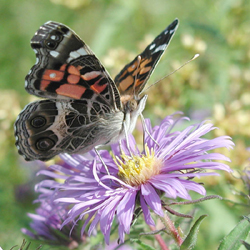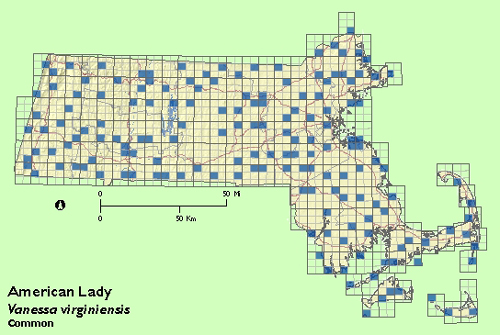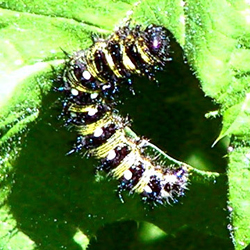Butterfly Atlas
Find a Butterfly
American Lady
Vanessa virginiensis
Named
Drury, 1773

Identification
Wingspan: 1 3/4 ‑ 2 1/8". Easily confused with Painted Lady (V. cardui). Both are largely orange above have forewings with blackish borders and white‑spotted blackish apex; hindwings with a row of small submarginal eyespots. The American Lady may be easily separated by its eyespot pattern on the underside of the hindwing: two large, black‑bordered eyespots on the present species; four small and one tiny eyespot on V. cardui. The summer form is larger and brighter than the fall form.
Distribution
Continent‑wide, from southern Canada south through Central America to Venezuela and the Greater Antilles. Also naturalized on the Galapagos, Hawaii, Azores, Madeira, and Canary Islands. Vagrant in other parts of western Europe. In New England, occurs throughout, although more sparingly northward.
Status in Massachusetts
Throughout the Commonwealth, the American Lady is a common butterfly. During the Atlas project, it was found at all elevations, from the Berkshires to Nantucket and Martha‘s Vineyard. Populations are subject to yearly fluctuations, but on a diminished scale in comparison with the Painted Lady. All of the Atlas years, 1986‑1990, were good for the species, as was 1994, while 1991‑1993 were comparatively poor. Adults are usually found in relatively low numbers at any particular site. Maximum: 1000, South Monomoy Island (Barnstable Co.), 20 September 1983. This is an exceptionally high count for this species, with next highest count being 28, Prescott (Hampshire Co.), 10 July 1994.

Flight Period in Massachusetts
Two overlapping flights ‑ usually mid‑May to late October. Extreme dates: 15 April 1994, Woods Hole (Barnstable Co.), R. Hildreth and 19 November 1985, Millis (Norfolk Co.), B. Cassie.
Larval Food Plants
Larvae feed on a range of composites, most frequently the closely related Sweet Everlasting (Gnaphalium obtusifolium), Pearly Everlasting (Anaphalis margaritacea), and pussytoes (Antennaria, sp.). Also fond of garden variety Edelweiss (see Notes).
Adult Food sources
Utilizes many available nectar sources, from Shadbush and Chokecherry in spring to asters and goldenrods in fall; also, many cultivated flowers (19 November record at garden chrysanthemums). Found nectaring at 38 species during the Atlas period.

Habitat
Open areas of all types, where nectaring and food plants occur.
Life Cycle
EGG: Yellowish‑green; high dome‑shaped, with 13‑16 vertical ribs. OVIPOSITION: Egg laid singly, on the upper surface but under the interwoven hairy covering (tomentum) of the hosts‘ leaves. LARVA: Black, with red and white spots and numerous branched black spines on each abdominal segment, the segments separated by bands of black and yellow stripes. Larva live in conspicuous nests, formed by silking together several leaves and often flowerhead of food plant. PUPATION: Often occurs within the larval nest. CHRYSALIS: Yellowish, with a few darker stripes and two conical projections at the head end. OVERWINTERING STAGE: Hibernate as adult butterflies or overwinter as pupae.
On warm May days, overwintering adults become active, to be joined in early June by fresh specimens, newly emerged from the chrysalis. All of these American Ladies are products of the previous year‘s summer generation, some hibernating as butterflies, others overwintering as pupae. Males of the species perch on low vegetation during the afternoon hours; mating occurs from afternoon to dusk. The fall emerging generation is said, by Scudder (1889), to be "always the most abundant."
Notes
Larvae of the American Lady are among the easiest to find, especially in late summer/fall when everlastings are so conspicuous. Look for nests among the flower heads at this season. Also, visit nurseries in June and examine potted plants of Edelweiss. An Atlas worker found 150+ larvae at a Massachusetts nursery and many scores at an Ottawa, Canada outdoor market, all in June.
Account Author
Brian Cassie



